The AMD Ryzen Threadripper 3960X and 3970X Review: 24 and 32 Cores on 7nm
by Dr. Ian Cutress, Andrei Frumusanu & Gavin Bonshor on November 25, 2019 9:05 AM ESTPower Consumption
One of our key conclusions from our Ryzen 9 3950X review is that AMD’s TDP number on the box was now somewhat a blurred line, with the processor instead taking the ‘Package Power Tracking’ or PPT value as its true peak power consumption. This meant that for a processor to have 105 W TDP on the box, the default PPT of 142 W meant that we saw power consumption around 142 W rather than 105 W. One concern going into this review is that AMD would take a similar line with the Zen 2-based Threadripper parts as well.
Both of the TR 3960X and TR 3970X processors have a list box TDP of 280 W, which is a new ‘record’ for high power consumption in a consumer CPU. In the enterprise space we see some specialist processors break the 400W mark, but those CPUs exist in environments with a variety of cooling methods and sound isn’t much of a concern. Conversely, these AMD processors will have to live in a box under someone’s desk, so there has to be a point where the TDP is too much. Last AMD generation was 250W, this one is 280W: if we’re not there already, then this should be a practical limit. AMD of course recommends liquid cooling with a good pump and a big radiator, so anyone buying one of these processors should look into spending at least another $120+ on a good liquid cooling system.
For our power consumption metrics, we performed our usual testing: using an affinity mask to limit the cores in use, implement a high-powered workload, and then measure the power readings 30 seconds in. We take the power readings from the processor itself, using the internal registers that are designed to regulate how much the processor does a form of turbo but also regulate temperatures and so forth. This method is broadly accurate, assuming the motherboard supports the external reporting of these values, but depending on the processor family it also gives us insights into how much power is being derived from the cores individually and the package as a whole.
Here’s what we get for the 24-core 3960X:
When a single core is active, it consumes ~13.5 watts. This slowly goes down when more cores get loaded, but at 6 cores loaded we are still consuming ~12 watts per core. Even at 16 cores loaded, we’re still around 10 watts per core. This is pretty impressive. At full core loading, we’re fluctuating between 6 and 11 watts per core, as workloads get moved around to manage core loading.
From the peak power perspective, we hit 280 W with 22 cores loaded. It drops off a bit after that, like we saw with the Ryzen 9 3950X, but not by much at this time. It should be noted that as we reach these higher values, out of those 280 W, around 205 W is being used by the cores, while 75 W or so is for everything else: that means memory controllers, PCIe root complexes, and the infinity fabric. This 75 W value doesn’t vary that much, starting at 68 W even at single core load. This indicates that either IF doesn’t take much power as more cores are used, or it is on all the time.
Moving to the 3970X, and we see a similar picture:
With more cores, the power is spread around a lot more. One core loaded tops out at 13 watts, and at 11 cores loaded we can still manage above 10 watts per core. When fully loaded, we move down to as low as 3 W per core, but it does average out to around 6 watts per core. Checking the frequency at this loading and despite the 3.7 GHz base frequency, we actually have all the cores at 4.0 GHz. 32 cores at 4.0 GHz? Yes please.
The peak power metrics rise to just over 280 W when we hit 23 cores loaded and stay there, with no dip after hitting the peak. It would seem that the 3970X appears better built in that regard.
If we comment on the power between the cores and everything else, we again get a 205-210 W value for the power in the cores. This leaves 75 W or so for the rest of the chip, almost identical to the 3960X, and again this doesn’t waver much from 1 core loaded to all-cores loaded.
What will be interesting to see will be when we get the 3990X in to test as comparison. I expect that 75W value to go up – even if it goes to 100W, that leaves 180W for 64 cores, or around 3 W per core. Based on my estimates, we could be looking at anywhere from 3.0-3.5 GHz per core, which actually fits in nicely with the frequencies of the EPYC 7H12 which is also a 64-core 280W part, but for the high performance compute market.
When comparing peak power consumption to all the other CPUs in our review, as expected our new CPUs are near the top of the charts.
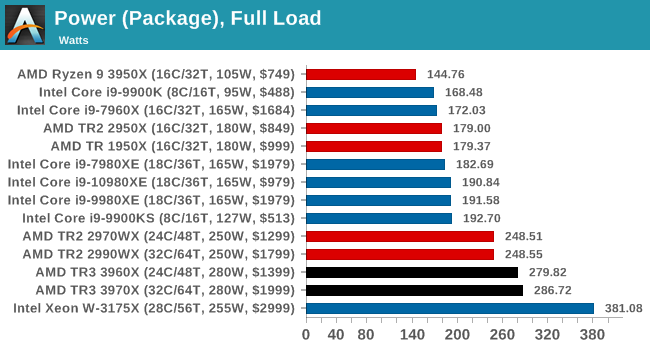
Only the unlocked 28-core from Intel peaks at a higher power, but funnily enough, that should only have a 255W TDP. So for four more cores, AMD’s peak power is still 100W below Intel’s. That’s the ‘power’ of the 7nm process node and some good quality chiplets.


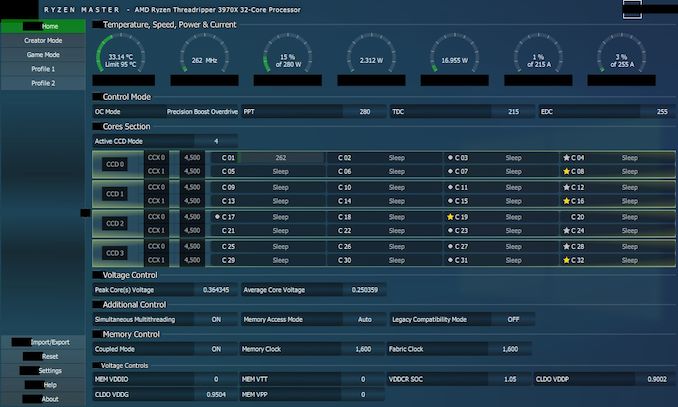
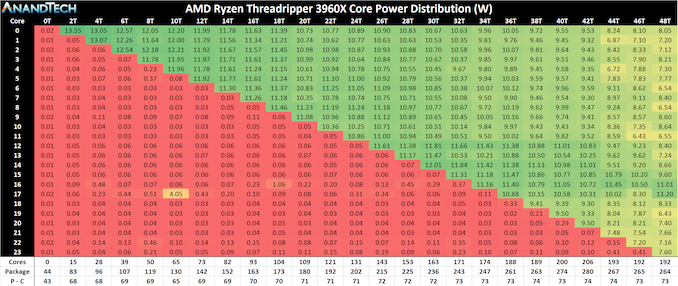
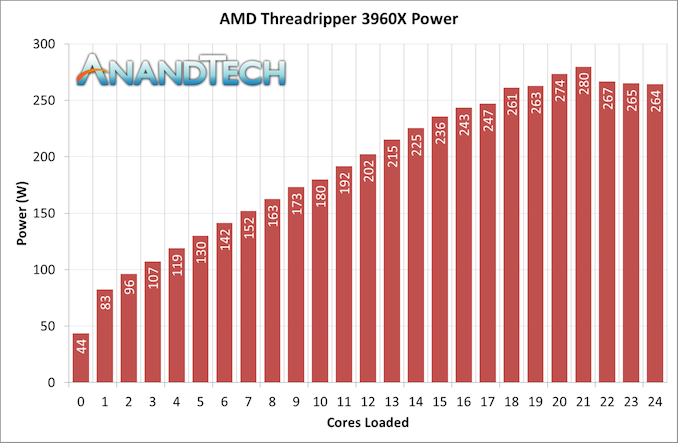
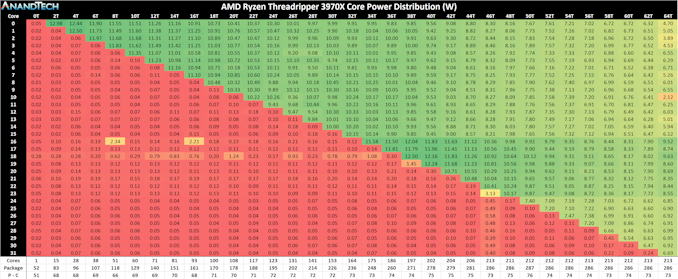
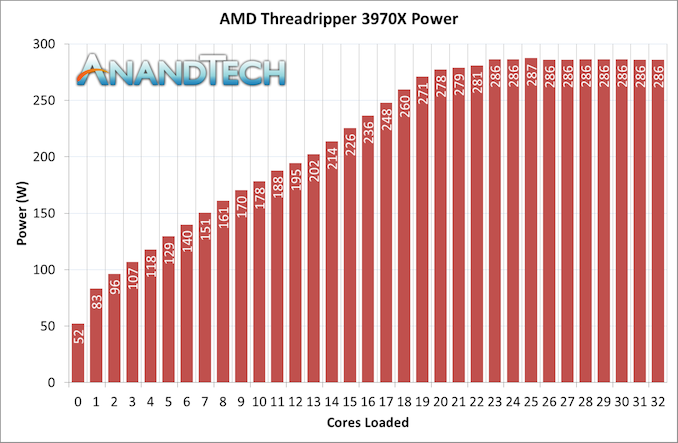








245 Comments
View All Comments
Dizoja86 - Thursday, November 28, 2019 - link
"Intel is going to have to have a shift its design strategy to compete."im.thatoneguy - Tuesday, December 3, 2019 - link
Any temperature stats? You recommend a good water cooler so it would be helpful to know how the thermaltake ring did under load.cdb000 - Sunday, January 26, 2020 - link
Seconded!In fact, a good write-up on how to cool a 280W CPU that is continuously running flat out.
My (old, slow) 1950X is cooled by a 280mm AIO and gets to ~61C when run flat out. These new Threadrippers use 55% more power which suggests that a 420mm or 480mm radiator will be required.
pvrvideoman - Thursday, December 5, 2019 - link
Great for AMD! Popular YouTube tech reviewers and others really need to stop saying that AMD has "crushed" Intel. That is just stupid. What they have done is deliver a very powerful, competitively priced product that delivers mostly the same or better performance at different price points. The desktop market is small. It's not making AMD or Intel all that much money. But it is great when companies like Amazon and Google talk about moving forward or transitioning to AMD Epyc line of processors. The enterprise and High Performance Computing contracts are where the real victory lies.tamalero - Tuesday, December 24, 2019 - link
holy intel apologist batman..alpha754293 - Monday, December 16, 2019 - link
When are the results from the benchmarking for the AMD Threadripper 3970X going to be on the benchmarking database?I tried looking for it just now and couldn't find it listed when I wanted to compare that and the AMD Ryzen 3950X.
Thanks.
lxxxxl - Thursday, December 19, 2019 - link
Is Chromium compilation still on the list of tests?And these new Threadrippers are not in Bench database?
soultorntech - Monday, December 23, 2019 - link
People concerned about the price between AMD and Intel HEDT processors need to calculate the per core cost and they will find out that the cost between the HEDT processors are pretty close. Add in the fact that Threadripper has a lot more L3 cache than the 10980XE plus can utilize up to 4 times as much RAM then the price of Threadripper 3 processors are a little easier to justify.stefanbatros - Sunday, December 29, 2019 - link
Hi everyone,I bought a 3970x + a Gigabyte Designare mobo. These will be used in a 4GPU setup for rendering and physics simulations.
Right now I have to chose between these 2 Ram kits, which are available and at a decent price in my country:
1. Corsair VENGEANCE® 128GB 3000MHz C16 -750$
2. G.Skill TridentZ 3000MHz C14 - 981$
Do you guys think that the C14 Gskill justifies the 200$ dollar difference? Will it be great improvement over the C16?
I am leaning toward the Vengence more because of price +is in stock in store + it is low profile and it will fit better with the Noctua nh-u14s tr4-sp3.
Any suggestions will ge appreciated.
Thanks,
Stefan
InfernusTitan - Friday, January 3, 2020 - link
A GTX 1080?Not Bottlenecking a 32 Core CPU in any ways??? I know core counts doesnt matter that much but still.